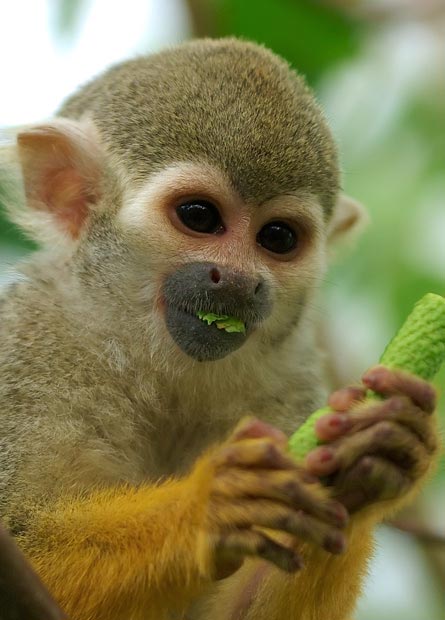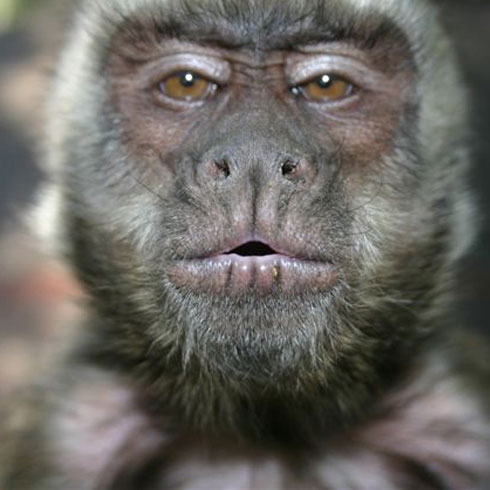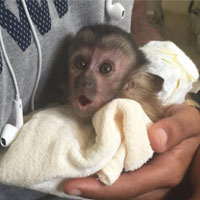One of our smaller species, common squirrel monkeys reside within our sanctuary in harmony with the larger capuchins and spider monkeys. Because of their tiny size, they are often tricky to photograph in the wild (see Bushbabies Photo Contest!) and are naturally vulnerable to predators such as hawks, jaguars and snakes. Relatively independent in nature, squirrel monkeys (even those kept as pets) generally do not crave human attention as other known species have, such as the inquisitive capuchin monkey.
Physical Characteristics:
The squirrel monkey's colouration is grey with traces of red-orange fur and yellow-orange arms, hands and feet. Their ears have small tufts of white fur on the ends, as well as around their eyes. Upon looking closer, one can see the circle of brown-black fur surrounding their mouths. Squirrel monkeys are very light: males weigh 554-1150g, and are only approximately 318mm long.
Females are slight heavier at 651-1250g, and approximately 316mm long. In case you find yourself spotting squirrel monkeys in their natural habitat, take note that the other subspecies, saimiri boilviensis or Bolivian squirrel monkey, has a much darker head and larger tail than the common squirrel monkey. The tail of both species is non-prehensile.
Habitat:
Squirrel monkeys naturally range from Brazil in the east of South America to Peru and Ecuador in the northwest (generally along the Amazon River). These primates live in the tropical lowland rainforest of the river, in a humid and damp environment. Squirrel monkeys spend much of their time in the trees as well as on the ground, making them quadrupedal-arboreal. They are not however good jumpers, leaping only about 2m or less at a time.
Diet:
Squirrel monkeys are insectivore-frugivores. Therefore, their diet consists mainly of insects and fruit. It is not uncommon to see them eating worms and butterflies as they forage. In the wilds of the New World, they have even been known to attack and eat small birds and bats! It can be said that squirrel monkeys are certainly not lazy, as they only spend roughly 10 percent of their day resting.
Life Cycle:
Squirrel monkeys give birth to a single offspring, for which the gestation period is 145 days. Females assume the most responsibility of the young's upbringing, with the infants being carried on their backs for about a month after birth. On average, squirrel monkeys live for about 20 years




 Conservation in Southern Africa is rapidly becoming unsustainable without the active involvement of the community, especially the younger, more active generation. The Bushbabies Monkey Sanctuary and The Elephant Sanctuary group strongly believe that we have to get the younger members of communities involved to instill a passion for the environment and wildlife in them through education.
Conservation in Southern Africa is rapidly becoming unsustainable without the active involvement of the community, especially the younger, more active generation. The Bushbabies Monkey Sanctuary and The Elephant Sanctuary group strongly believe that we have to get the younger members of communities involved to instill a passion for the environment and wildlife in them through education. I'll introduce you to Joyce, for example. A young female capuchin, she was rather pampered with child-like paraphernalia; a dress and a small hat around her head. Cute, indeed. She had been with her "foster" family since only two months old, bought straight from a breeder. The couple who owned her did not have children, and so decided to substitute the missing link with a primate, albeit a bit smaller...and with sharper teeth.
I'll introduce you to Joyce, for example. A young female capuchin, she was rather pampered with child-like paraphernalia; a dress and a small hat around her head. Cute, indeed. She had been with her "foster" family since only two months old, bought straight from a breeder. The couple who owned her did not have children, and so decided to substitute the missing link with a primate, albeit a bit smaller...and with sharper teeth.



